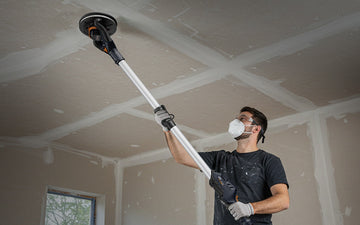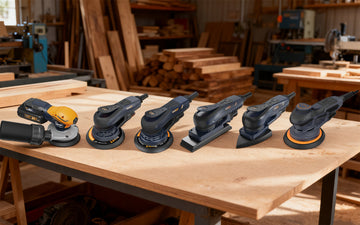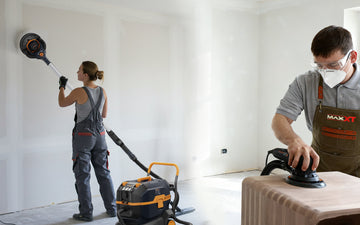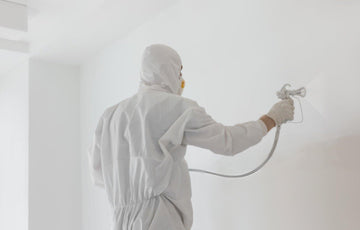When sanding drywall for paint, smoothing means everything. Straight, flat walls are achieved through hours of careful gritting and specialised sanding. With correctly chosen grits and the correct method, sanding is relatively easy and satisfying.
First-timers often consider sanding to be just rubbing on the wall until it seems “ok” at that moment. This is a misconception. Sanding is indeed an art. It needs a knowledge of grit; pressure influences outcome, and learning when to stop. Too much or too little sanding produces the same kind of problem.
In this article, we will tackle everything from why grit matters to preparation for walls to tools that help lighten work during sanding, and finally, the correct tools to use for sanding. With this, you will be well on your way to sanding drywall like a pro in no time, even if you have never held a sanding block before!
Benefits of Choosing Grit Properly
Now that we have stated the importance of choosing the correct grit, let’s get into the specific grit types.
Smooth and Uniform Surfaces
That grit provides the ideal surface texture for the primer to bond effectively. Then, the paint should flow evenly over the surface and make clean and polished walls. Since uneven surfaces create shadows under light, good sanding would eliminate the problem.
Prevention Against Over-sanding
By using the proper grit, sanding too hard into the drywall paper or over-polishing its surface is avoided. Both improper actions will create long-term issues too huge to be covered. A small dent in the drywall paper is one such example that will eventually show through all layers of paint, even after patching and re-sanding.
Fewer Imperfects
Smooth Sanding relieves all scratches and prevents any from coming through the paint. It can also create quite a professional appearance, even for the novice. In addition, it reduces the extra paint coats required, thus saving on time and cost.
Adhere Well
Correct selection of the grit ensures that the surface has an adequate configuration of microscopic roughness that allows coatings to grip. Proper adhesion, of course, keeps the coating from peeling, flaking, or bubbling with time, making the paint job last longer.
Better Finish Durability
A properly sanded wall is exposed to less damage because the paint bonds uniformly across its surface. Hence, it improves the initial look of the wall and helps maintain the finish for a long time, given the extreme conditions of everyday use.
Sufficiency in Materials
When walls are prepped with the right grit, the primers and paints will deposit so well and evenly. Material efficiency is, thus, keeping waste down, lower, and the overall project costs.
Sandpaper Grit Comparison Table
This table reflects the differences in sanding with different grits.
|
Grit Range |
Surface Action |
Best Use Case |
Risk |
|
80-100 |
Very coarse, removes quickly |
Rarely used, only for stubborn spots |
Highest risk for gouging into drywall paper |
|
120-150 |
Medium grit, close to removal |
First sanding, after the compound dries |
May scratch drywall if too much pressure is used |
|
180-220 |
Fine grit, smooth |
Last pass prior to prime |
Dust clogs quickly |
|
240+ |
Extra fine, only polishing |
Touch-ups or blending edges |
Not very good for large areas |
Preparing the Wall Prior to Sanding
Prior planning makes any sanding job more effective and safer.

Safety and Set-Up Procedures
Sanding produces fine, irritating dry-wall powder; therefore, always wear a respirator/dust mask and goggles. The correct tools are essential: use a pole sander or drywall sander for larger wall areas, while sponge sanding works for corners. Set ventilation or use a dustless-system sander to minimise cleanup. Consider laying dropcloths to protect floors and furniture.
Pre-Sanding Wall Prep
Before sanding, inspect all seams and patches carefully. If deep imperfections are found, apply a coat of joint compound and allow it to dry well. Never sand wet compound, as it clogs the sandpaper, causing streaking. Feel the wall with your hand and pencil-mark the rough areas; spots are your core focus. Once you've done this, you will save the trouble of redoing the entire section later.
Managing Dust
Sanding drywall is so dusty, but some easy solutions can certainly help put dust under control. Seal off doors and vents with plastic, and use a vacuum cleaner, if they have one. After sanding is finished, the walls are wiped using a damp cloth. Some professionals also use tack cloths for an extra-clean finish.
Time-Saving Hacks for Faster Sanding
There are quick ways of saving time while sanding. Drywall sanding can be best done quickly, with some shortcuts to get a perfect, smooth, professional finish.
Pre-Moistened Sanding Sponges
Wetting a sanding sponge can help to get airborne dust particles while improving blending in corners.
Utilise a Pole Sander Extension
Reach ceilings or high walls without having to lug around ladders; it also provides a level of strokes and reduces fatigue.
Mark Trouble Spots
Before sanding, mark the defects so that they are highlighted with a pencil. This way, you do not have to check the entire wall over and over again.
Vacuum-As-You-Go
Attach it to your shop vac or your sanding tool, and you will save a lot of cleanup time and make imperfections invisible.
Batch Work
Instead of changing tools every 5 minutes, batch-in welding seams, corners, and flat wall surfaces together. It will save time.
These hacks make DIYers labour smart instead of hard because they will reap all the benefits of the marathon sandings without having all the hassle.
Wall Prep Checklist Table
Use this checklist to ensure your walls are properly prepared before you begin spraying for the best possible finish.
|
Step |
Tool(s) Required |
Why This Works |
|
Put on protection |
Respirator, goggles |
Prevents inhaling dust into the lungs and eyes |
|
Inspect seams |
Flashlight, pencil |
Preemptively identify imperfections |
|
Patch defects |
Joint compound, knife |
Keeps dips from forming under the paint |
|
Ensure it is bone-dry |
Patience, airflow |
Prevents clogging of sandpaper |
|
Dust control |
Plastic, vacuum |
Keeps the job site clean |
|
Wipe walls |
Damp cloth |
Promotes adhesion of paint |
Extra Notes on Preparation
This isn't just busy work; each step bears directly on the outcome of your finish. For example, skipping dust control can, in most cases, bring peeling paint much later. With that in mind, take about 10-15 minutes to prepare well and reduce the sanding time for a wall truly ready for painting.
Step-By-Step Drywall Sanding Guide
So, now we will go through the actual sanding process step-by-step.
Step 1: Preparation
When moisture within the compound is absent, begin sanding with 120-150 grit sandpaper. Sweep using light circling motions, concentrating on removing ridges and tool marks. Begin sanding from the top downward so as not to have dust falling onto the unsanded areas. Have an even stroke at all times.

Step 2: Smoothing the Seams and Joints
This is where most of your time spent sanding is found. Feather the edges of the compound into the drywall around it so that seams "disappear." You must ensure that you do not sand into the tape beneath. In the case of corners, sponge sanding while keeping the sponge slightly angled will also help keep the lines sharp. Check properly with your hand often for the smoothness of seams. For wide seams, slow down and work from the centre outward.
Step 3: Final Sanding
Last pass with 180-220 grit sandpaper. A very light sanding of all walls is done in order to maintain an even texture. Pay special attention to areas close to windows or ceilings as they catch light and highlight imperfections. Grab a flashlight and angle it; here, imperfections will be seen incognito.

Step 4: Clean Up Before Painting
After the sanding is done, wiping the walls with a little vacuum or sponge works. Check for scratches or uneven spots with good lighting, then touch up lightly where needed. Clean surfaces would guarantee a good base for primer and, hence, a good-looking paint.
FAQs
Should I Sand in Between Every Coat?
Light sanding between coats is always a good practice and sometimes critical. The most important sanding occurs after the last coat of compound, for if you do not sand at this stage, any ridges left will certainly show up in the final coat.
Should I Use a Sanding Block or a Pole Sander?
Both have their merit. A pole sander is useful for sanding large areas very fast, while a sanding block or sponge works better for edges and corners. Ideally, you would use a combination of both, depending on the size of the area being sanded. [3]
Can I Use One Sandpaper for All the Drywalls, Sheetrock, and Plasterboards?
Yes, of course. Drywall, sheetrock, and plasterboard sandpapers all revolve around the same properties: being similar products for all the sanding needs one may have. The main focus is to choose sandpaper according to grit levels. For drywall, sandpaper grit from 120 to 150 will be best for intermediate sanding, whereas one in the range of 180 to 220 grit should always be reserved for the final holes before priming.
What is Drywall Sanding Screen, and When Should I Use It?
The drywall sanding screen is something that's built as a replacement for regular sandpaper and has a mesh that allows dust to be extracted efficiently, not being crushed with very little blockage during sanding with a pole sander ahead of painting. They are available in the finer grit for drywall sandpaper of 150-220, and they do create a smooth surface easily with far less mess.
Final Thoughts
Sanding drywall may not be the buzzword, yet whatever goes here is setting up all else. Without sanding, paint is only used as a spotlight on imperfections instead of a camouflage. Picking the right grit and investing time in prep will surely save a lot of pots and tons of effort.
In another light, sanding is what polishes the whole project. If one sticks to the order of medium grit, then fine grit, even a novice in drywalling, can achieve near-professional results. When accompanied by good dust management and safety awareness, sanding will be nothing but a truly rewarding experience.
Smooth walls are not just a matter of aesthetics; they are a sign of your craft, an acknowledgement of durability and pride in your work.
Hyperfit Tools: Sand Smarter, Prep Faster
Hyperfit Tools takes all the fuss away from drywall preparation, arming you with everything you need for sanding victory. The sanding sponges, pole sanders, and dust control kits are engineered to enhance the ease and cleanliness of any DIY project. Each beginner-friendly product is affordable and built to last so that you don't have to bear the burden of professional results.
The disparity of frustration versus graceful sailing while patching a little hole to sanding out an entire room would largely depend on the tools. Order Hyperfit sanding tools today and see how drywall prepping could switch from labour-intensive to a fun step toward having perfect walls.




